Last year, when Seacology agreed to fund the rehabilitation of the Community Center (Bayanihan Hall) of Palaui Island, Cagayan Province in exchange for the island villagers’ commitment to protect their 2,172.5 hectares of watershed forest, not much thought was given to the typhoons that regularly hit this tiny green dot on the map once or twice every year. After all, the islanders are no strangers to typhoons (the Philippines is hit by an average of 20
Community Center (Bayanihan Hall) of Palaui Island, Cagayan Province in exchange for the island villagers’ commitment to protect their 2,172.5 hectares of watershed forest, not much thought was given to the typhoons that regularly hit this tiny green dot on the map once or twice every year. After all, the islanders are no strangers to typhoons (the Philippines is hit by an average of 20  typhoons per year), and they have gone through some of the worst. But two particular typhoons this year were different.
typhoons per year), and they have gone through some of the worst. But two particular typhoons this year were different.
No less than five typhoons came within a hundred kilometers of the island this season. Three followed the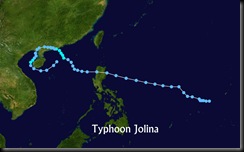 usual pattern of coming from the southeast and proceeding either north, northeast or northwest. Two however made paths that made it seem like they had a mind of their own.
usual pattern of coming from the southeast and proceeding either north, northeast or northwest. Two however made paths that made it seem like they had a mind of their own.
First was Typhoon Isang on the second week of July with winds of up 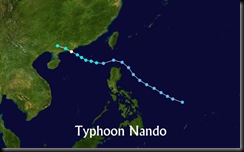 to 120 km per hour. At its heels came Typhoon Jolina on the first week of August, which while weaker at 75 km per hour almost made a direct hit. In the mainland Jolina left 8 fatalities. Typhoon Nando came on the second week of September also with 75
to 120 km per hour. At its heels came Typhoon Jolina on the first week of August, which while weaker at 75 km per hour almost made a direct hit. In the mainland Jolina left 8 fatalities. Typhoon Nando came on the second week of September also with 75  km per hour, triggering landslides, road closures and evacuations in nearby Kalinga Province.
km per hour, triggering landslides, road closures and evacuations in nearby Kalinga Province.
Then came the unusual typhoons. Category 4 Super Typhoon Pepeng came straight from the southeast and headed directly for Palaui. It went past Cagayan Province, then went back 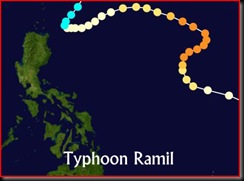 and made landfall again, going back and forth during the first two weeks of October for a total of three landfalls before finally heading out towards Hainan Island, China.
and made landfall again, going back and forth during the first two weeks of October for a total of three landfalls before finally heading out towards Hainan Island, China.
On the third and fourth week of October, Category 4 Super Typhoon Ramil tracked like it  was going past the Philippines, going east northeast of Palaui a little bit. Then it unexpectedly veered straight for the island like a dive bomber, and just as suddenly, it pulled up before actually making landfall and headed north.
was going past the Philippines, going east northeast of Palaui a little bit. Then it unexpectedly veered straight for the island like a dive bomber, and just as suddenly, it pulled up before actually making landfall and headed north.
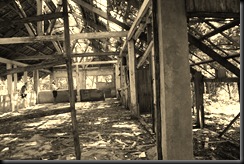 All this time, we in Manila were a bit concerned about how the typhoons affected the Community Center being constructed in the island. The Advocate of Philippine Fare Trade (APFTI), Seacology’s partner in this project, had little to report as communication with the islanders
All this time, we in Manila were a bit concerned about how the typhoons affected the Community Center being constructed in the island. The Advocate of Philippine Fare Trade (APFTI), Seacology’s partner in this project, had little to report as communication with the islanders 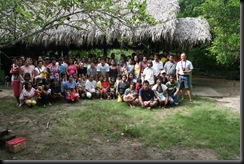 was spotty. Travel was made extremely difficult too, as four bridges to Cagayan Province were damaged in Pepeng’s aftermath.
was spotty. Travel was made extremely difficult too, as four bridges to Cagayan Province were damaged in Pepeng’s aftermath.
So when APFTI consultants Chen and Louie Mencias informed me that the Palaui Community Center is 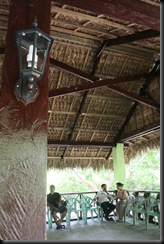 finished and invited me for a visit at the end of November, I jumped at the offer.
finished and invited me for a visit at the end of November, I jumped at the offer.
We left Manila by bus, 7:00 pm on November 27, 2009, and arrived at the Sta. Ana Pier about 10:00 am the following day. A 20 minute boat ride brought us to the house of Mang Diony, in whose backyard we made camp during our visit last year.
According to Mang Diony, they were left relatively unscathed by the typhoons. Problems in the  construction of the Community Center were more on the difficulties encountered ferrying the construction materials to the island than anything else. The thick foliage of the primary and secondary growth forest kept the winds from doing any damage, even as much of the mainland was reeling from the succession of typhoons.
construction of the Community Center were more on the difficulties encountered ferrying the construction materials to the island than anything else. The thick foliage of the primary and secondary growth forest kept the winds from doing any damage, even as much of the mainland was reeling from the succession of typhoons.
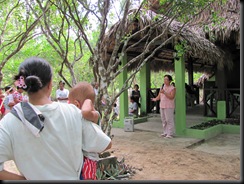 Palaui is legally protected under the National Integrated Protected Area System Act (passed by Congress in 1992), and like many of the areas defined in the NIPAS Act, little or no community consultation was done, resulting in little or no community support. The original structure was built by the
Palaui is legally protected under the National Integrated Protected Area System Act (passed by Congress in 1992), and like many of the areas defined in the NIPAS Act, little or no community consultation was done, resulting in little or no community support. The original structure was built by the 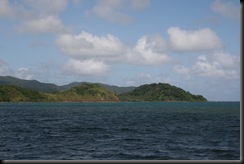 Department of Natural Resource and Environment in late 1993, but it was never maintained over the years. Illegal logging and “slash and burn" farming occasionally occurred due to lack of agricultural land, decreasing productivity of the soil and the need to
Department of Natural Resource and Environment in late 1993, but it was never maintained over the years. Illegal logging and “slash and burn" farming occasionally occurred due to lack of agricultural land, decreasing productivity of the soil and the need to 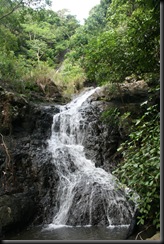 produce food crops for the local population.
produce food crops for the local population.
We proceeded to the Community Center where we were met by Barangay Captain Edgar Ugale. The building we saw is a far cry from the rundown shack we saw last year. There is a kitchen, a serving area, two toilet enclosures, a shower area, a stockroom where the solar powered batteries are kept, a guest room, and a wide activity center. The anahaw roofing keeps temperatures cool even at noon. The water tank outside, fed by a  hand pumped deep well, keeps water flowing throughout the building. A solar panel jutting out of the roof provides clean and renewable electricity.
hand pumped deep well, keeps water flowing throughout the building. A solar panel jutting out of the roof provides clean and renewable electricity.
Simple ceremonies, where the villagers reaffirmed their commitment to protect their watershed for 20 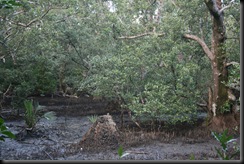 years, marked the turnover of the Community Center to the care of the community. Alternative livelihood training programs will be conducted in the center, with the hoped effect of easing economic pressure off the watershed. It will also serve as a place where the villagers may gather and organize themselves.
years, marked the turnover of the Community Center to the care of the community. Alternative livelihood training programs will be conducted in the center, with the hoped effect of easing economic pressure off the watershed. It will also serve as a place where the villagers may gather and organize themselves.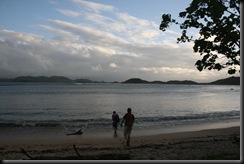
As a tourist destination, Palaui has much to offer. In the island are three beautiful waterfalls, several potential nature trails for flora and fauna enthusiasts, and numerous rest points with scenic views. Narra and other high value hardwood trees are 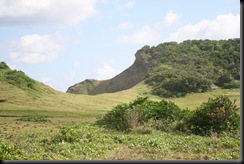 abundant, as are birds and butterflies not often seen anymore in mainland Luzon. There is no electricity, and lodging is limited to camping or home-stay (renting a room from a local). But maybe it is better this way as too many tourists and tourism-related establishments may impose too heavy a tax on the fragile ecosystem.
abundant, as are birds and butterflies not often seen anymore in mainland Luzon. There is no electricity, and lodging is limited to camping or home-stay (renting a room from a local). But maybe it is better this way as too many tourists and tourism-related establishments may impose too heavy a tax on the fragile ecosystem.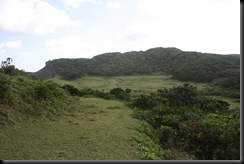
After lunch with the community, we headed out for one of the waterfalls. The one-hour hike wasn’t too bad, even if we did wade through a few creeks, cross a rickety two-plank hanging bridge, and stare down a couple of barking dogs along the way. My 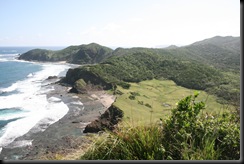 shirt was wet with sweat by the time we got there, but I think anyone would feel as reinvigorated as I did after seeing all that clear water cascading down the steep slope.
shirt was wet with sweat by the time we got there, but I think anyone would feel as reinvigorated as I did after seeing all that clear water cascading down the steep slope.
The following day, we went to the northern tip of Palaui – Cape Engaño, where the last lighthouse built by the Spaniards in the Philippines is located.
According to the lighthouse keeper, the Americans built the perimeter wall of the lighthouse and the Japanese used it as a garrison during World War II. And it is also supposed to be haunted by the ghosts of the Japanese troops that died defending it at the end of the war. He said he would sometimes wake up to the sound of marching boots just before dawn, though nothing or no one was ostensibly making it.
 As spooky as the lighthouse keeper’s stories may be, one cannot help but be enchanted just by the panoramic view from the lighthouse. From the beaches of the east and west shores start the grasslands, and from thence the edges of the forest. Where we were, we witnessed the huge waves crashing on the left side in contrast with the calm sea on the right. It is as good a metaphor as any of the island defending against the wildly changing weather patterns.
As spooky as the lighthouse keeper’s stories may be, one cannot help but be enchanted just by the panoramic view from the lighthouse. From the beaches of the east and west shores start the grasslands, and from thence the edges of the forest. Where we were, we witnessed the huge waves crashing on the left side in contrast with the calm sea on the right. It is as good a metaphor as any of the island defending against the wildly changing weather patterns.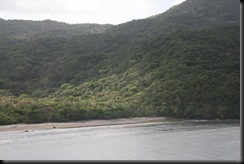
Food for thought as we left the island for the overnight bus trip back to Manila.
No comments:
Post a Comment